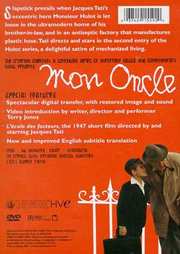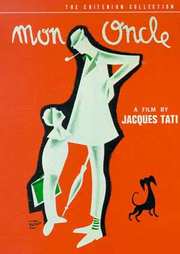Mon Oncle (Region Free)
A delightful satire of mechanized living
Certificate: none
Running Time: 116 mins
Retail Price: $29.95
Release Date:
Content Type: Movie
Synopsis:
Slapstick prevails when Jacques Tati`s eccentric hero Monsieur Hulot is let loose in the ultramodern home of his brother-in-law, and in an antiseptic factory that manufactures plastic hose. Tati directs and stars in the second entry of the Hulot series, a delightful satire of mechanized living.
Special Features:
Video Introduction by Writer, Director and Performer Terry Jones
L`ecole des facteurs, The 1947 Short Film Directed by and Starring Jacques Tati
Video Tracks:
Pan & Scan 1.33:1
Audio Tracks:
Dolby Digital Mono French
Subtitle Tracks:
English
Directed By:
Jacques Tati
Written By:
Jacques Tati
Jacques Lagrange
Starring:
Jean Meyet
Lucien Frégis
Adrienne Servantie
Jean-Pierre Zola
Jacques Tati
Soundtrack By:
Alain Romans
Franck Barcellini
Director of Photography:
Jean Bourgoin
Editor:
Suzanne Baron
Costume Designer:
Jacques Cottin
Production Designer:
Henri Schmitt
Producer:
Alain Terouanne
Jacques Tati
Fred Orain
Louis Dolivet
Distributor:
Criterion


































Your Opinions and Comments
When you first see Monsieur Hulot, the whimsical wanderer played by Jacques Tati in the classic French comedy Mon Oncle, it takes a moment to realize just how big he is a two-meter slab of trenchcoat and fedora, his lips perpetually pressed around the stem of a black pipe. He is often seen from the back a gangly giant observing life's oddities, curious, perhaps bewildered, but not disapproving.
Despite his size and his intense awareness of his environment, he moves with lightfooted grace, personalizing the world around him in a series of small, charming, seemingly offhand gestures. Early in the film, he opens a window in his flat and hears a bird chirp for a split second. Intrigued, he opens and closes the window until he figures out precisely why and when the bird chirps: at a certain point on its axis, the windowpane reflects a beam of sunlight onto the bird's nest, making it think that morning has come. Pleased by his discovery, Hulot wedges the window in sun-reflective position so that the bird may sing indefinitely. ...
There is mystery to Hulot, a sense that he lives mostly in his own world, occasionally adjusting the wider world to make it more livableor at the very least, more reflective of his own eccentric desires. Mon Oncle, arguably Tati's best and most pleasing movie, is an illustration of the actor-filmmaker's myopia a myopia which afflicts everyone in the modern era to some degree, and which Tati brilliantly explored in meticulous physical comedies.
The story of a young boy who prefers his absentminded uncle to his rich, acquisitive, gadget-obsessed parents, it presents a world in which characters are defined solely by their actionsactions that are often captured from a distance, in tableaus packed with people, structures, streets and vehicles, all working at cross-purposes yet somehow managing (just barely) to function. ...
Tati's Hulot, the Oncle of the title, is a simple man with simple needs who often finds himself bewildered by the mindless complexity of modern city life. The filmmaker has often been described as a miniaturist, and the label fits; as a director, Tati relies on long shots that transform people into figurines in a clockwork landscape of doodled dioramas. Cars drive in regimented rows along freshly paved thoroughfares, following flowchart-style networks of arrows that guide them onto sidestreets and finally into parking lots segmented into identical, boxy parking spots; a place for everything, and every man in his place (a concept that will be explored more elaborately in Playtime and Traffic).
Hulot's apartment building anachronistic, yet charming and well preserved, just like Hulot looks in long shot like a dollhouse. As Hulot ascends to his flat on the top floor, we catch glimpses of him through square windows. None of the building's other residents see Hulot's humorous, accidental disappearing-reappearing act, and Hulot doesn't see them, either. Or perhaps they all unconsciously choose to ignore one another a condition of city life we all can recognize. ...
Much of Mon Oncle is like this a voyeuristic comedy in which the only person spying is the audience; Rear Window played for whimsy. Like the characters in Hitchcock's apartment complex, Tati's people are sketches of urban anthropology. The film's situational humor encloses them boxes them, figuratively and sometimes literally, like zoo animals (though at least zoo animals know they're caged). We study them, realize how much we share with them, and smile. ...Tati's gift was his ability to see how his own goofy, oblivious singlemindedness was reflected not just in others, but in Western civilization, which became increasingly crowded, hectic and gadget-obsessed during the middle part of the 20th century. He was an ex-vaudevillian, a prodigiously gifted comic and a notorious perfectionist, fond of characters that live in their own private dreamlands and are bewildered when life doesn't rush to meet their needs. Keenly aware that modernization eliminated some cherished virtuessolitude, contemplation and a sense of connectionTati's comedies show us how technological changes dismantled the old idea of community. ...
Like Tati's handful of other movies as writer-director, Mon Oncle allies itself with the visual strategies of Charlie Chaplin, Buster Keaton, Harold Lloyd and the silent-era Laurel and Hardy. It uses sound the way Chaplin used sound in City Lights and Modern Times as tapestries of aural gestures (car horns, footsteps, bird calls) that accentuate the director's economical, cartoonlike style. Dialogue is avoided unless absolutely necessary; Tati would rather identify characters mainly by their dress, posture and behavior, and by how they interact with their complex, impersonal and often silly environment. A rich business owner wears a stuffy suit and tie and glasses; his blandly chipper, consumerist wife wears "comfortable" dresses that resemble pastel-colored shopping bags. ...Their house, like the city that encloses it, is designed to trumpet the ingenuity of engineering while calling attention to its lack of functionality. The front walk is serpentine, which turns every visit from a guest into a spectacularly pointless (and endless) grand entrance; the lawn is carved into jigsaw-puzzle patches of differently colored grass, all of them far too pretty for a child to play on. At the center of this monstrous lawn is a sculpture of a fish jutting up out of the soil like Excalibur. It shoots water towards the sky at the flick of an indoor switch; the woman of the house only trips the switch when company outside the front gate waits to be buzzed in. Visitors can hear the gushing of the fish as it's turned on, thus undermining its impressiveness. In this gag repeated, delightfully, throughout Mon Oncle you can see the gears of social need turning, just as you can see the gears of urban life turning elsewhere in the picture. ...
Tati's work is all about the gears how they turn, how they interlock. At once a minimalist and a ringmaster of spectacle, he constructs elaborate visual contraptions successions of gags, linked by theme rather than story which illustrate the mechanisms behind our modern world. Hulot (like Tati, and like the audience) exists both inside and outside the machine, a gentle and melancholy sentry, taking notice and taking part, commenting and living; a clockmaker making clocks with transparent faces. He wants us to see the gears and appreciate their scale and precisionand realize how their very existence turns us into gears, too.
Mon Oncle is presented in its original theatrical aspect ratio of 1.33:1. This new digital transfer was created from a 35mm interpositive. The sound was mastered from the 35mm magnetic tracks. Image restoration: Daniel Sellier; Sound restoration: Sophie Tatischeff, Specta Films; Telecine colorist: Richard Deusy, Scanlab, Saint Cloud
For those who have never seen a `Criterion Edition` I would point out that they have always taken pride in obtaining - and sometimes themselves creating - the best possible negative to make a (originally Laserdiscs) DVD - if only all companies would take as much care there would be little need for the comments about the picture and sound quality.
Also on the disc is an introduction to the film by Terry Jones and the 1947 short directed and staring Jacques Tati `L`ecole des facteurs`